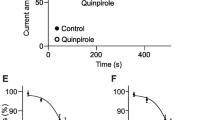Abstract
The velocity of propagation of thein vitro retinal model of spreading depression is very sensitive to changes in the ionic composition of the extracellular medium and also to the the addition of different drugs. 10 μ.M of SKF 38393, a D1 agonist, increases the velocity of propagation of the wave while 10 μM of Quinpirole, a D2 agonist, decreases it. Both changes are blocked by their specific antagonists, SCH 23390 and 1 -sulpiride respectively. This assay can biologically screen potential dopaminergic drugs indicating its physiological D1 and/or D2 preferred effect in the tissue for future analysis by other different methodolgies.
Similar content being viewed by others
References
Brann, M.R. and Young, W.S. III (1986). Dopamine receptors are located on rods in bovine retina.Neurosci. Lett. 69: 221–226.
Carlson, J.H., Bergstrom, D.A. and Walter, J.R. (1987). Stimulation of both D1 and D2 dopamine receptors appears necessary for full expression of postsynaptic effect of dopamine agonists; a neurophysiological study.Brain Res. 400: 205–218.
Chesler, M. (1990). The regulation and modulation of the pH in the nervous system.Progr. Neurobiol. 34: 401–427.
de Azeredo, F.A.M. (1991). Transient changes in energy metabolites and intracellular pH during spreading depression in the chick retina.Met. Brain Dis. 6: 75–82.
Dowling, J.E. (1987).The Retina: an Approachable Part of the Brain. Harvard University Press, Cambridge, Mass.
Dubocovich, M.L., Weiner, N. (1985). Pharmacological differences between the D-2autoreceptors and the D1 dopamine receptor in the rabbit retina.J. Pharmacol. Exp. Therap. 233: 747–754.
Elena, P.P., Denis, P., Kosina-Boix, M. and Lapalus, P. (1989). Dopamine receptors in rabbit and rat eye: characterization and localization of D1 and D2 binding sites.Current Eye Res. 8: 73–83.
Kebabian, J.W., Beaulieu, M. and Itoh, Y. (1984). Pharmacological and biochemical characterization of two categories of dopamine receptors.Can. J. Neurot. Sci. 11: 114–117.
Kebabian, J.W. and Calne D.B. (1979). Multiple receptors for dopamine.Nature 277: 93–96.
Moghaddam, B., Schenk, J.O., Stewart, W.B. and Hansen, A. J. (1987). Temporal relationship between neurotransmitter release and ion flux during spreading depression and anoxia.Can. J. Physiol. Pharmacol. 65: 1105–1110.
Qu, Z.X., Fertel, R., Neff, N.H. and Hadjiconstantinou, M. (1989). Pharmacological characterization of rat retinal dopamine receptors.J. Pharmacol. Exp. Therap. 248: 621–625.
Rodrigues, P.S., Guimaraes, A.P.O., de Azedredo, F.A.M. and Martins Ferreira,H. (1988). Involvement of GABA and ACh in retinal spreading depression: effect of low calcium -high magnesium solutions.Exp. Brain Res. 73: 659–664.
Seeman, P. and Gregoriadis, D. (1987). Dopamine receptors in brain and periphery.Neurochem. Int. 10: 1–25.
Stoof, J.C. (1983). Dopamine receptors in the neostriatum: biochemical and pharmacological studies. In Kaiser, C, Kebabian, J.W., (eds.),Dopamine Receptors, American Chemical Society Press, Washington, pp. 117–145.
Stoof, J.C., Kebabian, J.W. (1984). Two dopamine receptors: biochemistry, physiology and pharmacology.Life Sci. 35: 2281–2296.
Trabucchi, M., Spano, P.F., Tono, C.W., Frattola, L. (1976). Effect of bromocriptine on central dopaminergic receptors.Life Sci. 19: 229–232.
Tsurata, K., Frey, E.A., Grene, C.W., Cote, T.E., Eskay, R.L. and Kebabian, J.W. (1981). Evidence that LY-141865 specifically stimulates the D2 dopamine receptor.Nature 292: 463–465.
Author information
Authors and Affiliations
Rights and permissions
About this article
Cite this article
de Azeredo, F.A.M., Ribeiro, M.F. A simple biological way to screen dopaminergic agonists. Metabolic Brain Disease 7, 211–221 (1992). https://doi.org/10.1007/BF01000247
Received:
Accepted:
Issue Date:
DOI: https://doi.org/10.1007/BF01000247




